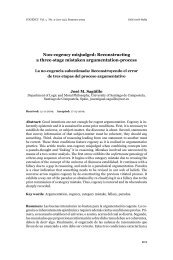Cogency v2 n2
Cogency v2 n2
Cogency v2 n2
Create successful ePaper yourself
Turn your PDF publications into a flip-book with our unique Google optimized e-Paper software.
COGENCY Vol. 2, N0. 2, Spring 2010<br />
This is a very impressive analysis, and one that seems to provide us with<br />
criteria from getting from the image to the proposition in a fairly stable<br />
way. Given Slade’s contention that Blair and Fleming operate on too narrow<br />
a conception of argumentation it is striking that Slade produces as her<br />
demonstration of an argument embedded in a purely visual medium an argument<br />
that would satisfy the conception of argumentation they use. As a<br />
response to Blair and Fleming, it is a sound strategy in that it shows that<br />
visual argumentation can be found that meets even their (on her view, overly)<br />
strict conception of the argumentation involved. What is striking about it is<br />
that she generates this argument by the application of semiotic principles of<br />
interpretation that are supposed to be operative at the level of argumentation<br />
seen not as premise-conclusion argumentation, but as a dynamical interchange<br />
involving more than just that sort of argument. Regardless of what<br />
the Wittgensteinian perspective says about the possibility of visual argumentation<br />
of the sort Slade suggests, the connection her view displays between<br />
the wider and narrower senses of argumentation, I think, retains its<br />
force and its interest.<br />
Despite the appearance presented by her key example, Slade makes no<br />
claim that images can be propositional. Were she to say that, all the same<br />
points that count against the Birdsell and Groarke analysis would count<br />
against hers as well. Since she does not explicitly make that claim, let us<br />
simply leave the matter at that. The Wittgensteinian notion of “seeing as”<br />
will prove to be far more relevant to the evaluation of her case for purely visual<br />
arguments. To return to this purpose let us now ask, does Slade’s view<br />
fare any better than Birdsell and Groarke’s on Wittgensteinian criteria?<br />
Recall that “seeing as” was not a process of extracting a hidden meaning<br />
in an image. It was not a matter of interpretation, of revealing what the<br />
image says. Rather, “seeing as” is a matter of adopting a particular attitude<br />
towards an image, expressible in terms of counterfactual statements, that<br />
permits the person seeing the image to see it in a certain way (e.g. now as a<br />
duck, now as a rabbit). The question of whether the attitude thus taken provides<br />
access to something unequivocally communicated by the image itself<br />
is moot. The connection between this perspective of “seeing as” and the indeterminacy<br />
of interpretation suggested by PI 139b should be clear. What<br />
an image “says” is largely going to be a matter of what the viewer brings to it<br />
in terms of contextual knowledge and cultural or linguistic framing. This,<br />
126








